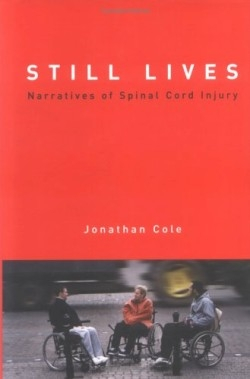It looks like you've stumbled upon a page meant to be read by our code instead of viewed directly. You're probably looking for this page.
Still Lives
Narratives of Spinal Cord Injury
What is it like to live in a wheelchair, without sensation and movement in the body?
According to the author, “The answer is found in the experiences of those in that position, but in fact there is no single answer, for each person has different responses to their injury.”
For this book, Cole chose to interview twelve people in the United Kingdom who have similar impairments, but differing experiences. How these individuals responded to their new way of living has shaped the book into six sections: enduring, exploring, experimenting, observing, empowering, and continuing. The interviewees were either tetraplegics (paralyzed from the neck down) or paraplegics (paralyzed from the waist down). All were in wheelchairs.
The author explains that there are 183,000 to 230,000 people in the United States who have such injuries, with 82% being male. About 58% of these males are between the ages of sixteen and thirty, like Colin, who at age nineteen sustained a spinal cord injury that prevented him from moving from the neck down. Thirty years later, Colin confides to the author that he sometimes contemplates suicide, but that what stops him from shooting himself is the fear that he will not succeed in killing himself. In the end Colin succeeds in holding a full-time computer job.
Julie Hill, one of the few women with a spinal cord injury, tells Cole that when she tried to overtake a car by speeding, her tire burst, and she was flung from the vehicle. Hill was the first person to have an elaborate series of electrodes implanted to stimulate the nerve roots as they leave the spine, below the level of her injury, allowing her movement in her previously paralyzed legs. Hill was married with two sons, ages four and six, at the time of her accident. She comments, “My disability has hardly prevented me from doing anything. On the contrary, it has given me a renewed lust for life.”
Cole is a consultant in Clinical Neurophysiology at Poole Hospital and Salisbury Hospital (which has a Spinal Centre); he is also a Professor at Bournemouth University, and a visiting Senior Lecturer at Southampton University.
Despite the lack of illustrations, which is the book’s one weakness, Cole succeeds in providing inspiring narratives of people who have spinal cord injuries. All were depressed at first because they realized how drastically their lives were changed. Robbed of their independence, they had to rely on their parents’ or spouse’s help. Eventually most of them have been able to lead somewhat independent lives.
This turnaround from complete dependence to some independence is a hopeful message; this book offers knowledgeable inspiration not only for doctors and medical personnel who deal with spinal cord injuries, but for all those who have such injuries and those who care for them.
Reviewed by
Ruth Wucherer
Disclosure: This article is not an endorsement, but a review. The publisher of this book provided free copies of the book to have their book reviewed by a professional reviewer. No fee was paid by the publisher for this review. Foreword Reviews only recommends books that we love. Foreword Magazine, Inc. is disclosing this in accordance with the Federal Trade Commission’s 16 CFR, Part 255.
